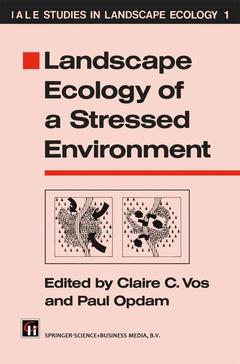Description
Landscape Ecology of a Stressed Environment, 1993
Authors: Vos Claire C., Opdam Paul
Language: English
Subject for Landscape Ecology of a Stressed Environment:
Keywords
Publication date: 10-2012
310 p. · 15.5x23.5 cm · Paperback
310 p. · 15.5x23.5 cm · Paperback
Description
/li>Contents
/li>
This series presents studies that have used the paradigm of landscape ecology. Other approaches, both to landscape and landscape ecology are common, but in the last decade landscape ecology has become distinct from its predecessors and its contemporaries. Landscape ecol ogy addresses the relationships among spatial patterns, temporal pat terns and ecological processes. The effect of spatial configurations on ecological processes is fundamental. When human activity is an import ant variable affecting those relationships, landscape ecology includes it. Spatial and temporal scales are as large as needed for comprehension of system processes and the mosaic included may be very heteroge neous. Intellectual utility and applicability of results are valued equally. The International Association for Landscape Ecology sponsors this series of studies in order to introduce and disseminate some of the new knowledge that is being produced by this exciting new environmental science. Gray Merriam Ottawa, Canada Preface In Europe, during the seventies, landscape ecology emerged as a fusion of the spatial approach of geographers and the functional approach of ecologists. The latter focused on ecosystem functioning, regarding eco systems as homogeneous, almost abstract units in space, with input and output of energy and matter to and from the undefined surroundings.
1 Patterns and processes in a landscape under stress: the study area.- 1 Patterns and processes in a landscape under stress: the study area.- 1.1 Introduction.- 1.2 Landscape types.- 1.3 Modern land use.- 1.4 Spatial relations.- 1.5 Effects of modern land use on natural ecosystems.- 1.6 Nature conservation strategies.- References.- One Spatial Relations by Water Flows.- 2 Nutrient enrichment of freshwater wetlands.- 2.1 Introduction.- 2.2 Enlarged inputs: rain, groundwater, surface water.- 2.3 Hydrology and soil conditions as factors controlling nutrient availability.- 2.4 Control of plant growth by nutrient availability.- 2.5 Consequences of nutrient enrichment for species composition.- 2.6 Implications for management.- References.- 3 Linking ecological patterns to hydrological conditions on various spatial scales: case study of small stream valleys.- 3.1 Introduction.- 3.2 Landscape analysis on a regional scale.- 3.3 Landscape analysis on a local scale.- 3.4 Evaluation of the hydroecological approach.- Acknowledgements.- References.- 4 Hydroecological modelling in a polder landscape: a tool for wetland management.- 4.1 Introduction.- 4.2 Landscape ecological characteristics of polder areas.- 4.3 The data: variables and sampling procedure.- 4.4 Processing the data to a model.- 4.5 Application of the hydroecological model.- 4.6 Discussion and conclusions.- References.- Two Spatial Relations by Air Flows.- 5 Atmospheric nitrogen deposition and its impact on terrestrial ecosystems.- 5.1 Introduction.- 5.2 Spatial variation in the deposition of nitrogen.- 5.3 Accumulation and mineralization of nitrogen.- 5.4 Effects on the competitive balance between plant populations and the dynamics of species composition.- 5.5 Conclusions.- References.- 6 Ditch banks as a conservation focus in intensively exploited peat farmland.- 6.1 Introduction.- 6.2 Effect studies on ditch banks.- 6.3 Model study of the nitrogen balance of banks.- 6.4 Compatibility of ditch-bank management with current dairy farming practice.- 6.5 General discussion and concluding remarks.- References.- Three Spatial Relations by Moving Organisms.- 7 Population responses to landscape fragmentation.- 7.1 Fragmentation in the Dutch landscape.- 7.2 Ecology of spatially structured populations.- 7.3 Observations of fragmented populations.- 7.4 Discussion.- References.- 8 Metapopulation models for impact assessment of fragmentation.- 8.1 Introduction.- 8.2 Modelling strategy.- 8.3 On the risk of extinction.- 8.4 Winking patches metapopulation models.- 8.5 Structured metapopulaion models.- 8.6 Discussion.- Acknowledgements.- References.- Four Methods and Concepts of Landscape Planning.- 9 Landscape planning for nature restoration: comparing regional scenarios.- 9.1 Introduction.- 9.2 A regional case study: the Central Open Space Project.- 9.3 Four scenarios for nature restoration.- 9.4 COSMO, a tool for evaluating the scenarios.- 9.5 Results of the evaluation for nature restoration.- 9.6 Discussion.- Acknowledgements.- References.- 10 The framework concept and the hydrological landscape structure: a new perspective in the design of multifunctional landscapes.- 10.1 Introduction.- 10.2 The hydrological landscape structure.- 10.3 The hydrological landscape structure and land use in the Twente region.- 10.4 A landscape plan for the study area in Twente.- 10.5 Evaluation.- References.- 11 Nature conservation and extraction of drinking water in coastal dunes: the Meijendel area.- 11.1 Introduction.- 11.2 Coastal dunes in The Netherlands, landscape ecological structure.- 11.3 The coastal dunes of The Netherlands as an area for the extraction of drinking water.- 11.4 The Meijendel dunes near The Hague: a case study.- 11.5 Conclusions.- Acknowledgements.- References.- 12 Artificial wetlands: a device for restoring natural wetland values.- 12.1 Eutrophication of wetlands.- 12.2 Artificial wetlands for eutrophication control.- 12.3 Eutrophication of wetlands in the Green Heart of Holland.- 12.4 Management strategies for ecological recovery of the wetlands in the Green Heart of Holland.- 12.5 Perspectives for application of artificial wetlands in the Green Heart.- 12.6 Conclusions.- References.- 13 Water relations in urban systems: an ecological approach to planning and design.- 13.1 Introduction.- 13.2 Step 1: Programme.- 13.3 Step 2: Rhythm.- 13.4 Step 3: Orientation.- 13.5 Step 4: Situation.- 13.6 Step 5: Adjusted technology.- 13.7 Discussion.- References.- Acknowledgements.
© 2024 LAVOISIER S.A.S.




